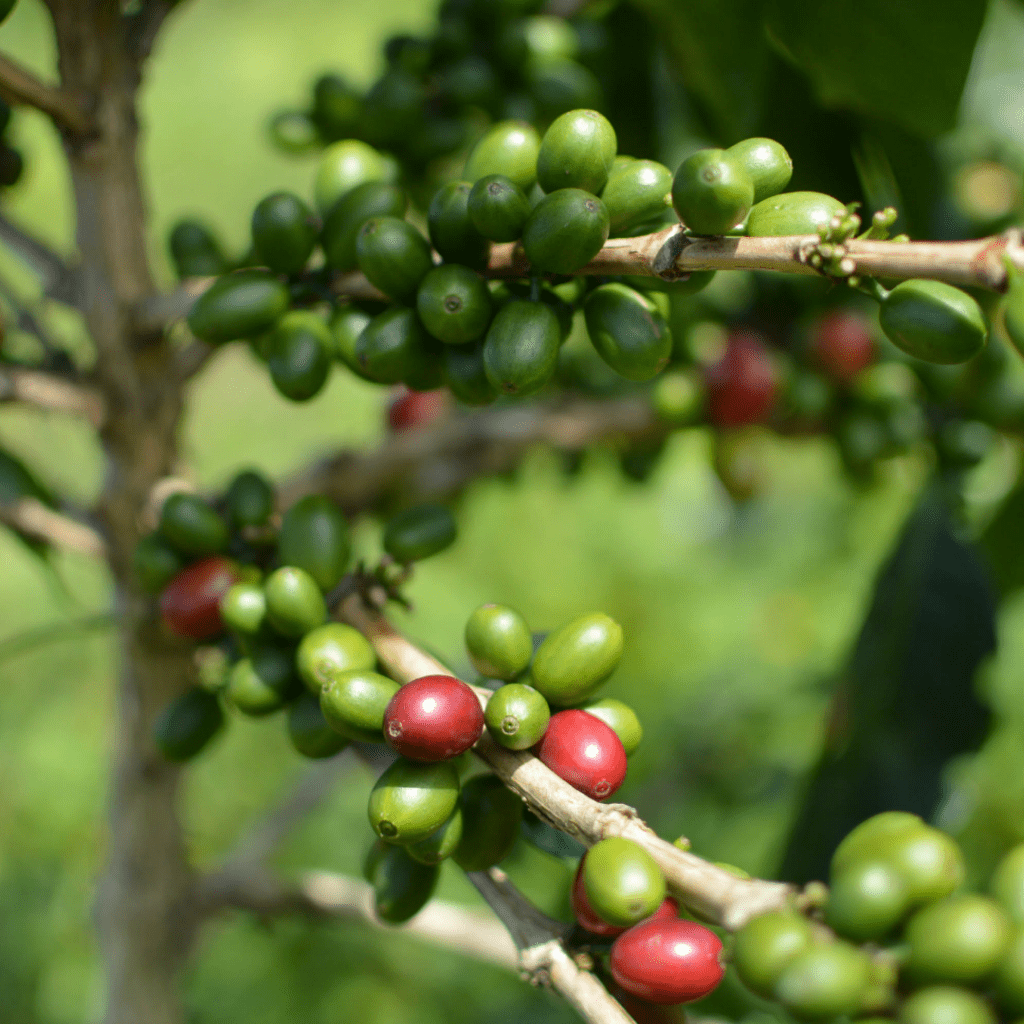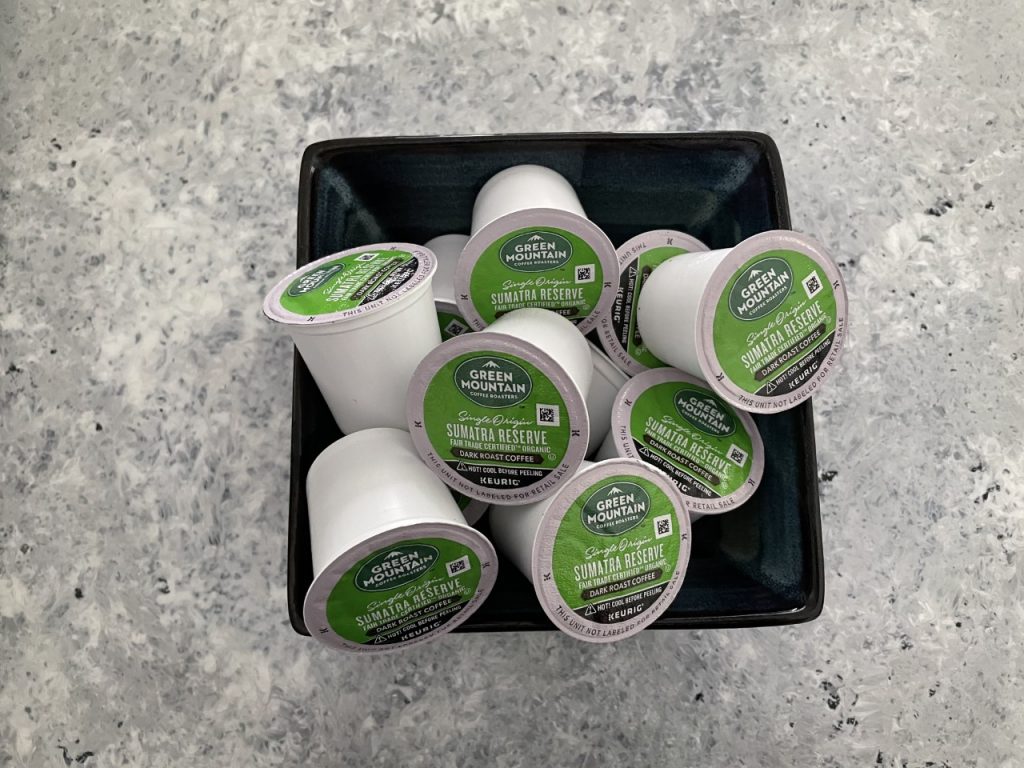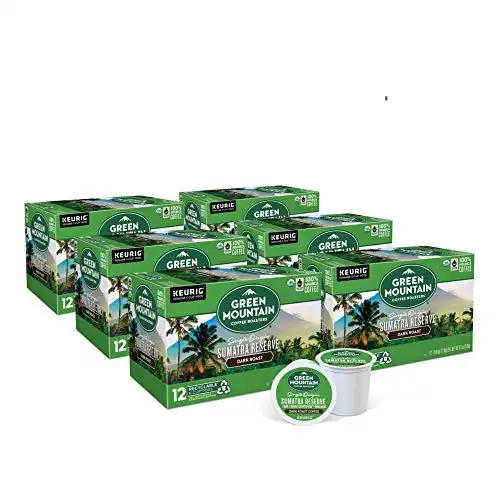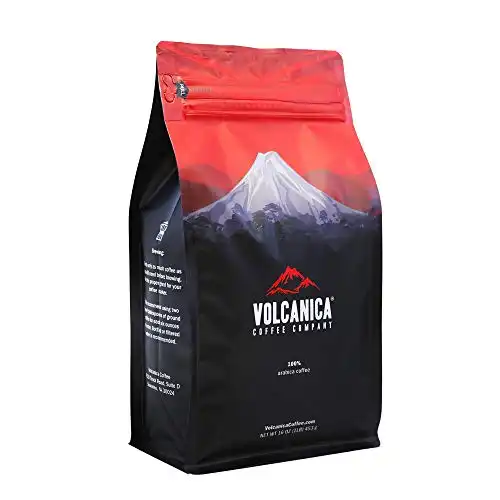What defines unique coffee?
Is it the flavor? Or its harvesting technique?
How about where it’s grown?
Well, in Sumatra, their tasty coffee is a result of several factors. Their complex flavor and low acidity make coffee from this area one of the world’s most sought-after coffee.
In this post, you’ll learn everything there’s to know about Sumatra coffee.
Before delving deep into some of the most amazing facts about Sumatra coffee, let’s first understand what this coffee is all about.
We want you to know this post contains affiliate links. If you click on a product and decide to buy it we may earn a small commission at no extra cost to you.
Quick Glance: Best Sumatra Coffee
Sumatra Mandheling By Volcanica |
| ||
Klatch Coffee Sumatra Mutu Black |
| ||
Coffee Bean Direct Sumatra Mandheling |
| ||
Starbucks Dark Roast Sumatra |
| ||
Coopers Cask Single Origin Sumatra |
|
What is Sumatra Coffee?
Cultivated from the fertile Indonesian island, this bean is known for its full body with spicy flavors of earthy notes and dried herbs. And once you drink it, you won’t help but feel the smoothness on your palate.
Some of the top coffee brands always add Sumatra coffee to their mix, thanks to its unique flavor profile.
The other reason why people can’t get enough of this coffee is due to its low acidity. So, folks with a sensitive stomach will find this won’t cause irritation.
Where Does Sumatra Coffee Come from?
Sumatra comes from the Sumatra Island, which is part of Sunda Islands – a group of islands located along Western Indonesia’s coast. Sumatra Island is the biggest in this group.
Sumatra coffee is named after this island.
Sumatra Island is an out-of-the-way location that can take time to reach.
Due to the remote location, nearly all of the coffee-growing region is rural-based and occurs on a small scale.
A great percentage of the landscape on this island is fertile. Its soil contains leftover ash deposits from a massive volcanic eruption that took place long ago.
The Sunda Islands are located along what is commonly called the coffee green belt.
It’s a perfect blend of hot and humid conditions with tropical weather, making it ideal for coffee farming.
What you’ll find even more interesting is the history part of this coffee.

The History of Sumatra Coffee
Sumatra is the world’s third-largest producer (after Brazil and Vietnam) of both Robusta and Arabica coffee.
But Sumatra isn’t just popular across the world; it’s also popular in the Republic of Indonesia, where it’s the country’s second-largest island.
Sumatra has a population of approximately 55 million people and is the region’s largest producer of coffee.
Sumatra’s crop size provides about 74.2% of Indonesia’s combined coffee product. The second-largest region provides only 12%.
But, coffee plants haven’t always been native in Indonesia; the Dutch government imported them to the island after they’d conquered the Portuguese during the early Dutch colonial period.
After two centuries, during the Second World War, more practical crops, such as cassava, corn, and rice replaced a greater quantity of the coffee harvest to support the livelihoods of those on the island.
Thus, the 1950 harvest was merely an eighth of the pre-war harvest. But, ever since, coffee production has grown in leaps and bounds to become the economy’s backbone.
Currently, Indonesia’s coffee exports are about 67% of its entire coffee production, bringing in $849 million in annual revenue.
Unlike most coffee-producing countries, smallholders own a whopping 95% of coffee plantations in Indonesia.
In other words, big corporations control only 5% of the country’s coffee crops. This means that small families and businesses benefit immensely from the coffee proceeds.
Smallholders are more than two million, meaning that sales made from all over the world will go towards supporting local farmers.
Is Sumatra Coffee Bitter?
The Sumatran coffee’s flavor may vary depending on the part of the island it originates from, and the processing criteria.
But one thing is certain: nothing else tastes like it!
In general, Sumatra coffee has a smooth, sweet, intense, and balanced body. The coffee captures the wild jungle essence of the Indonesian island.
The Sumatran coffee is less acidic with the richness and smoothness that lingers on your tongue’s back corners. The finish has notes of chocolate.
Does that sound like bitter coffee? Not at all.
That said, to maintain Sumatra coffee’s non-acidic experience, you should go with the medium to dark roast.
Kopi Luwak: Love It or Hate It
Take a trip to Sumatra, Bali, or any other gorgeous island within Southeast Asia and you’ll quickly notice that kopi luwak is a type of coffee everyone talks about.
So, what the heck is kopi luwak?
Well, it’s coffee made from partially digested cherries that the Asian civet has eaten and passed out in its excrement. The other names for this animal include civet cat, palm civet, or simply Luwak.
Yep, you heard it right!
Simply put, the civet eats and poops the coffee beans, which is how the coffee type earns the name “cat poop coffee”.
You may be tempted to check the calendar and confirm whether it’s April 1st, but I kid you not!
And it gets crazy…
Kopi luwak is the world’s most expensive coffee (we’re talking anywhere $100 and $600 per pound)
Why is that so?
It’s one of the world’s best-tasting coffees for various reasons. One of the reasons is that the civet is a super picky eater and only feeds on the best, most ripe beans.
Here’s the second reason: the civet’s digestive enzymes improve the coffee’s flavor.
Why You Shouldn’t Buy It
While pure Kopi luwak is worth tasting, about 70% of the Kopi luwak coffee sold at coffee stores and online isn’t 100% pure. Worse, it doesn’t contain any genuine coffee.
In other words, fake sellers attempt to sell the most expensive coffee at a high cost with the lowest production cost. As a result, the coffee is substandard.
That’s one reason you shouldn’t try Kopi luwak.
The second reason is rather a disturbing one.
After realizing that Kopi luwak is highly profitable, the farmers began harvesting the beans unnaturally.
Instead of focusing on the product’s natural cultivation, the farmers started looking for strategies that can yield the highest possible profits.
They did something crazy.
They gathered and caged a massive number of civet cats and began to overfeed them exclusively on coffee beans.
The enslavement industry causes many animals to succumb to diseases and even death.
What’s more, the caged civets don’t pick the choicest coffee berries as the wild civets do, because farmers often force them to feed purely on cherries.
Thus, the coffee Luwak produced by these caged animals is of lower quality than that of wild animals.
So, if you’ve to buy Kopi luwak, ensure it’s from a certified seller.
5 Facts about Sumatra Coffee
To help you understand Sumatra coffee on a deeper level, here are five must-know facts about it.
Special Processing Method That Impacts the Flavor
It’s easy to overemphasize how location affects the taste of coffee. As earlier intimated, the coffee taste is dependent on where it’s farmed on the different areas of Sumatra Island.
But that’s not the only factor affecting the flavor. Processing also comes into play.
Wet Hulling
Sumatra coffee undergoes a processing method known as wet hulling or Giling Basah. This approach is different from other coffee processing techniques used in other areas of the world like Ethiopia, for example.
Here are the steps involved in wet hulling:
- As soon as they pick the coffee cherries, farmers use homemade machines to quickly peel off the skin from the cherries.
- They place skinned beans in woven bags so they can ferment throughout the night.
- In the morning, farmers wash off the remaining fruit or mucilage by their hands.
- Next, the farmers partially dry the coffee beans in the parchment, which takes place in the yard.
- The beans undergo shipping to the warehouse. Here, the parchment is removed and the beans keep on drying.
- The beans are shipped to the port where they dry for the third time while awaiting exportation.
Wet Hulling Leaves Higher Moisture Levels in Coffee
A wet climate dominates Sumatra, and that’s why farmers don’t usually dry the beans. While this climate is ideal for coffee farming, it can pose a challenge when it comes to processing.
Most coffee processing methods involve drying coffee beans until the moisture content drops to 9% to 11% when out of the processing facility.
Since wet hulling includes drying at three phases, the moisture content remains at 11% or above for long – usually until the exportation stage.
How Wet Hulling Impacts the Flavor of Sumatra Coffee
A greater percentage of Sumatran coffee’s uniqueness comes from wet hulling. The improvised natural processing approach and more drying time result in a coffee with muted aromas and flavors.
A Complex Flavor Profile
As already mentioned, Sumatran coffee has a higher moisture content, which is why it continues to ferment while in storage and up to the period before roasting.
The fermentation process helps in the development of the coffee’s dynamic flavors. When sipping Sumatra coffee, its complexity will lead to an exceptional tasting experience.
Rather than being popular for their notes, Sumatra coffee is mainly known for its low acidity and full body.
The flavor and aroma featured are rather funky: wild, spicy, earthy, mushroomy, and mossy.
The flavor and aroma may be pleasant to some people, but not others, because the taste is a completely personal preference.
It is sweeter when dark roasted. The aroma is herby, umami and woodland-y
Generally, Sumatran coffee is complex, rich, and full-bodied. This is because of the dark roast.
The multi-stage wet-hulling using homemade machines and dark roasting helps build its body, enhance its characteristics, and add richness to its flavor.
But when roasted differently, it comes out with a brighter, fresher flavor.
A Dark Roast Profile
Most people think that Sumatran coffee should obviously be a dark roast, but that is the roaster’s call to make.
Coffee beans can be roasted at various levels, whether extra dark, full city, or light. As a reminder, lighter roasts highlight the bean’s origin, while a dark roast reflects the roasting process.
All in all, when it comes to Sumatra coffee, roasters often prefer a dark roast because it helps bring out the coffee’s chocolatey tones and natural sweetness to go along with its earthy complex flavors.
In sum, if you’re craving a roast with less acidity and lots of chocolate and nutty flavors ensure that the coffee is a medium roast also known as a full city.
Low Acidity
Sumatran coffee is one of the world’s coffees with the lowest acidity.
Here’s why.
As a rule of thumb, coffee planted at low altitudes has low acidity. So, being on the lower of Indonesia’s chain of islands, Sumatra produces low acidic coffee.
Many Varieties
Sumatra coffee exists in different varieties, with the common ones being:
Sumatra Lintong
Sumatra Lintong carries with it all the characteristics of Sumatra coffee in every sip you take.
Sumatra Lintong gets its name from its origin in the District of Lintong Nihuta, which lies in Lake Toba’s southwest area.
It is the largest planting area of this coffee variety. The coffee does better in volcanic soils experiencing wet climates.
The whole Lintong Nihuta region provides an ideal altitude for Arabica coffee, thanks to the high plateau the region rises to. The altitude stands at 1000-1600 meters above sea level.
The Lintong is a full-bodied coffee with a concentrated flavor blended with spices and herbal nuances.
This is not its natural disposition but a result of the unique and traditional method used in its production.
The parchment is hulled off the bean at about 50% moisture content against the about 12% moisture level common in many other regions.
The coffee is dried until it turns dark green.
The result is an exceptional flavor profile best known for its low acidity, chocolate, and herbal flavor notes, spiciness, and a lingering richness that would not leave the back of the palate.
For a consistent sweet taste, perfectly ripe fruits are chosen after intense hand sorting.
Sumatra Lintong came to the limelight in 1750 when this variety of Arabica coffee was brought to Sumatra by the Dutch trading company.
The large-scale cultivation of Sumatra Lintong started in 1888.
You can tell a high-quality Lintong coffee from other Sumatran coffees by its clean mouthfeel and exceptional bright acidity.
It also has a medium body and retains notes of fresh earth and dark chocolate.
Its fragrance is so strong that your whole kitchen will assume it’s consuming aroma when you are brewing it.
Sumatra Mandheling
About 65% of Sumatra Mandheling coffee grows on the volcanic slopes of Mount Leuser, which is near port Padang in the west-central (Black) region of Sumatra. Padang is actually a tiny island.
The commercial growth of Mandheling coffee began in the 18th century after its popularity expanded.
It stood out due to its unique shape and hue that helped the European merchants easily identify it and differentiate it from other varieties.
It is named after the people of Mandheling who originally farmed and processed the coffee beans from this region.
The production process gives the coffee its great, heavy body and the smooth, low acidity, rich, exotic flavor notes that leave a syrupy aftertaste in your mouth. Flavor notes include dried fruit, lemongrass, and toffee.
Its earthly richness can also not be overlooked, as coffee experts have pointed out.
Most processes hull coffee at about 10-12%, but the traditional Sumatran processing used (Giling Basah or Wet Hulling) for this coffee gives it the unique flavor garnished with herbal nuances and a spicy ending.
This processing involves hulling off the coffee parchment at close to 50% moisture content. This gives these green beans their well-known dark color.
For the Grade 1 Mandheling coffee, the beans are hand-picked up to three times to remove defects. The result is a consistent cup made purely of well-ripened cherries.
Sumatra Gayo
Sumatra Gayo originates from the Gayo region of Sumatra, specifically in the great mountain basin around Lake Tawar located in the town of Takengon.
This region, standing at 1000-1400 above sea level, produces high-quality Arabica.
The region is close to the equator and experiences a tropical climate, hence its coffee is harvested throughout the year.
The coffee is grown in the shade, and there are no chemicals used. It has a heavy, near-syrupy body and deep earthiness.
Sumatra Gayo is less known compared to the first two varieties already mentioned. Its processing is fascinating, though. Some farmers wash the beans in the backyard, while other farmers employ unique techniques.
Sumatra Gayo has been acclaimed internationally due to its sweetness and cleanliness. It boasts of a complex, deep flavor with a touch of smokiness. The Wet Hulling process used gives Sumatra Gayo its unique flavor.
Flavor notes are moist, fresh-fallen leaves, cacao nib, caramel, wisteria, peach.
Onan Ganjang
During the late ’80s, coffee farmers from Lintong came across a natural hybrid variety in Onan Ganjang village.
Excited, the farmers began planting the hybrid variety across the entire Lintong Nihuta region. The variety spread up to the Simalungun area.
Physical Characteristics
This tall coffee plant has broad, thick leaves and active primary branches. Its secondary branch growth gives it a wild look, making it difficult to view the main trunk/stem from outside.
The young leaves are usually light green. The leaves are typically narrow but with a pointy, wavy edge.
The flowering begins around 15 to 24 months after transplanting and flowers start to show when the wet/rainy season is just starting.
This plant yields flowers throughout the year. One to two months after flowering, pinhead cherries start to appear, which results in 12 to 20 cherries on one node on the primary branch.
Fewer cherries grow on the secondary and tertiary branches.
The cherries have varying colors; the ripe ones are red but the young ones are green. The cherry is round but the cherry disc is wide and flat.
Ripening starts from 5 to 8 months, but it won’t occur uniformly. The beans are sizable but aren’t uniform. The plants produce 15.7% of green beans from the cherry’s weight.
Performance
Onan Ganjang is very productive and can produce anywhere between 1 and 1.15 tonnes of green beans when harvested.
But there’s a catch.
Such a massive harvest is only possible from a coffee farm with 1,600 to 2,000 plants per acre. This variety is highly resistant to coffee leaf rust (CLR).
The cupping profile of Onan Ganjang is excellent with the original Sumatran flavors. On top of that, Onan Ganjang is fruity and has a nice complexity. It has a syrupy body too.
Sumatra Typica
In the seventeenth century, the Dutch introduced coffee plants from Yemen. Initially, they were planted in West Java’s Buitenzorg (Bogor) and Batavia (Jakarta).
There were established coffee plantations in Central Java, East Java, and West Java, in Sulawesi, and parts of North Sumatra.
The coffee plants developed into three major Typical varieties:
- Sumatra Typica – for the varieties planted within Sumatra
- Blawan Pasumah – Planted in East Java’s Blawan Pasumah village
- Java Typica – Planted in Central and West Java
Unfortunately, disaster hit hard in the late 1800s after which coffee leaf rust affected Indonesia, destroying most Typica varieties.
But, a couple of Typical varieties planted at higher elevations in North Sumatra survived the disaster and are still visible to this day.
Physical characteristics
This variety is a tall plant with a height of 3.5 to 4 meters. Its lateral branches range from 50 to 70 degrees with the plant’s vertical stem, creating a conical shape.
Its leaves are narrow and small and the young leaves appear to be golden brown. But, in the dry season, the plant sheds most of its leaves due to the leaf rust disease.
The opposite occurs in the rainy season when the leaves crowd along the branches. Flowering starts from 48 to 52 months from the time of transplantation.
One to two months after flowering, you’ll start seeing the pinhead cherries, but the cherries mature slowly, taking as long as 8 to 12 months.
This can only mean there’s one peak harvest every year.
The ripe cherries feature a red color and the beans appear long and narrow-ended. The yield is approximately 15.4% of green beans of the cherry’s weight.
Performance
Sumatra Typica’s yield is low: 750kg per ton of green beans from a plantation of 1,600 to 2,000 plants per hectare.
The variety requires coffee shade trees because of its weak resistance to coffee leaf rust. But, it features an outstanding cupping profile: herbal and fruity with a long aftertaste, a big body, and complex acidity.
The SL795 Coffee Variety
SL795 is a Sumatran coffee variety named Jember by the locals. It is a Kent variety that originated from India.
SL795 landed in Sumatra way back in 1955. It is a hybrid variety created from the Kent variety and S288 variety. These two come from the Coffea Arabica family.
Physical Characteristics of SL795
SL795 is a tall variety with wide, dense leaves and very active branches. It has vigorous secondary growth that makes it look wild and disorganized.
Its stem is often hidden under the foliage and branches.
The young sprouts are bronze/golden brown in color. They look narrow and pointy and have a wavy edge.
Jember starts flowering after 15 to 24 months after transplantation. The flowers start blooming when the wet/rainy season sets in.
The flowering season will take a whole year. In one to two months after that, pinhead cherries will start forming. Each node will produce between 12 – 20 cherries on primary branches and a few secondary and tertiary branches.
Young cherries are often green but turn red when ripe. Each cherry’s disc is flat and wide while the cherry remains round.
Jember cherries ripen within five to eight months. However, they don’t often ripen uniformly. Its coffee beans are large.
This variety can yield about 15.7% green beans from the cherry weight.
Performance of Jember
Jember always has great productivity. It can yield up to 1.5 tonnes of green beans with each harvest. This yield is from 1,600 to 2,000 plants per hectare.
SL795 is resistant to coffee leaf rust.
It also has an excellent cupping profile. Even though it has a trace of Liberica in it, it doesn’t exhibit any characteristics of Liberica.
The research facility of Jember has produced up to eight other generations from SL795 due to its tolerance to rust and quality of cupping.
The USDA762 Coffee Variety
The USDA762 variety originated from Ethiopia, Typica. It came from the original Arabica coffee. Apparently, the Geisha coffee variety also originated in Ethiopia.
It came to Sumatra in 1956 when the US Department of Agriculture introduced it at the Jember Research Facility.
Both USDA762 and Geisha coffee varieties may have come from the same region, but each adapted differently. Many people still mistake USDA for Geisha though.
The first seeds of the USDA762 variety were planted in North Sumatra.
Physical Characteristics of USDA762
USDA762 is also a tall coffee plant that branches out sideways. Both the stem and branches of this coffee grow fast. They are brown in color and will exhibit an orderly growth that is quite regular.
Young leaves/sprouts are often golden brown or bronze. Its leaves are wide, with conspicuous veins and a narrow edge.
USDA762 starts flowering 32 to 34 months after seedlings are transplanted. The flowering starts at the beginning of the rainy season. It always follows a regular pattern.
Pinhead cherries will start appearing about one to two months after flowering. The nodes are often 6 to 10 cm apart and will have 12 to 24 cherries each.
Young cherries are matte green, with a long, narrow disc and a distinct goatee shape when they’re still green.
But when they mature, the goatee shape will disappear from the cherries. They will start forming a burgundy, red color as they turn round or plump.
USDA762 cherries do ripen uniformly within 6 to 9 months. All the beans are uniform in size. They appear along with a narrow end and will yield up to 16.6% green beans from the cherry.
Performance of USDA762 Variety
USDA is quite productive. It can yield between 800kg to 1.2 tonnes of green coffee beans with each harvest season when planted at a density of 1,600 to 2,000 plants a hectare.
The plants are resistant to coffee leaf rust too. But are susceptible to nematodes, so they require shade trees.
This Sumatran coffee variety has an outstanding cupping profile as well.
Final word
Sumatra coffee is unique not only in its flavor but also origin, processing, variety, and much more. You might love it or you might hate it – there isn’t much in between when it comes to Sumatra coffee but, you should without a doubt try it and decide for yourself!







